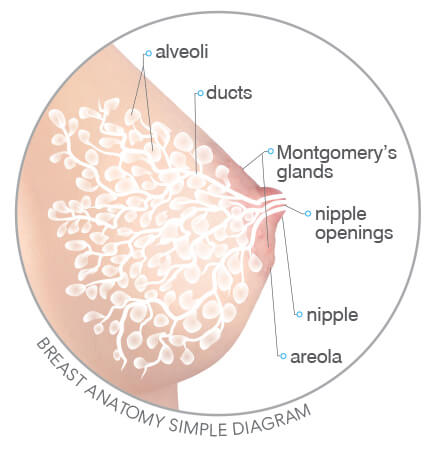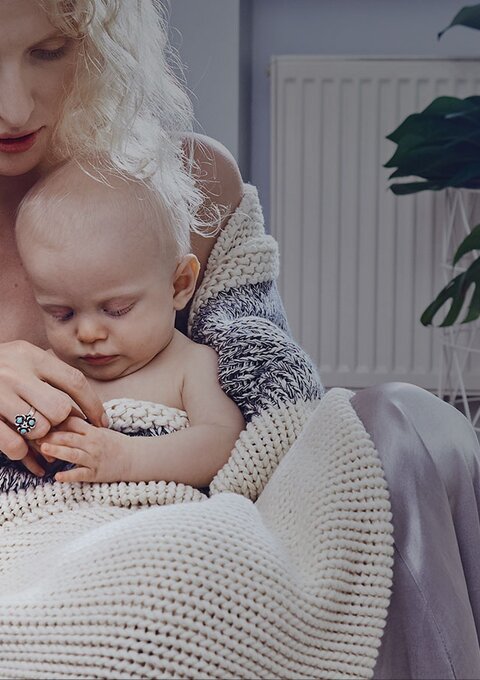What determines the production and flow of breast milk? How does suckling take place? Answers to these questions are extremely helpful when solving lactation and baby's suckling problems.
Milk production in the breasts and let down are strongly related to the mum's body response to sensory stimuli provided by the suckling baby and hormonal changes taking place in her body:
 While suckling the baby massages the nipple with his tongue and stimulates the sensory nerve endings in the nipple and areola.
While suckling the baby massages the nipple with his tongue and stimulates the sensory nerve endings in the nipple and areola.
The stimuli are transmitted to the mother's pituitary gland. The pituitary releases prolactin, a hormone responsible for milk production in alveoli. The more you breastfeed, the higher the prolactin level and the amount of produced milk.
Suckling also triggers the release of oxytocin - another hormone responsible for lactation. It stimulates contraction of the cells surrounding the alveoli and milk ejection into the milk ducts (so called oxitocin reflex, let down). The milk is transported in the milk ducts towards the nipple and the baby's mouth.
The suckling reflex appears at 17th week of gestation. The baby can now suck his own thumb. Fully developed suckling reaction involving coordination of suckling, swallowing and breathing appears in 32nd week of pregnancy. That is why most newborn babies are ready to suck milk from the breast. Suckling reflex is maintained up to 6 months of age, and then it becomes a controlled activity.
Great tiredness, nervousness, anxiety, fear, pain may inhibit the release of oxytocin, thus blocking milk let down - the milk remains in the alveoli and is not transported towards the nipple. Therefore, make sure you have enough rest and comfort in the first weeks of breastfeeding, and ask your family for help with daily chores.

It begins with baby's rooting reflex. You can trigger it by touching baby's mouth with the nipple. The baby opens his mouth wide, tightly covers the nipple and areola and extends his tongue - it allows for deep suckling of the nipple and creating vacuum inside the mouth.
By licking the breast with the tip of his tongue, the baby stimulates prolactin release, milk production and let down. The little one intuitively adjusts the speed of tongue movements, thus controlling the lactation intensity and milk ejection. Babies younger than 3 months usually are not able to control the let down rate by adjusting the suckling force.
This is the phase of intense, active work of lip and tongue muscles. The baby works hard to get his milk which slowly becomes thicker, more nutritious, filling and calorific - it satisfies hunger.
Nipple length is almost doubled during suction and then it shrinks again during swallowing. The baby's tongue presses it into the hard palate, and causes milk let down. Lips press against the areola so that vacuum is created in the baby's mouth, facilitating milk flow into the oral cavity. Soft palate is raised, epiglottis closes the entrance to the larynx and milk flows into the digestive tract. Then the epiglottis opens, the soft palate is lowered and the baby exhales.
Suckling in babies is very different from suckling in adults. Anatomy of the baby's mouth allows for inhalation, a few suckling movements, swallowing and exhalation (the baby does not breath after each suckling sequence). This way the baby can drink without the risk of choking - the respiratory and digestive tracts are not open at the same time.One of the most important things while breastfeeding is to make sure your baby is breathing freely through the nose. When he has a runny nose, suck the secretion before feeding.
At the beginning of a breastfeeding session milk contains a lot of water, is low in calories and it serves mainly to quench baby's thirst. The baby has no problems with expressing it. Then the little one has to work hard, as milk becomes thicker, and let down is slower, but this milk meets the infant's nutritional needs. Therefore quickly finished and too short breastfeeding sessions can leave the baby hungry, result in poor weight gain, baby's laziness while suckling and rejection of long suckling. Moreover, short breastfeeding sessions lead to poor milk expression, and contribute to milk stasis, finally promoting inflammation. Feeding babies at night is particularly important. Especially in the first days after birth. Night food contains a larger amount of fat, and thus is more calorific. Of course, pay attention to whether the baby suckles at the time of being at the breast or only holds the nipple in the mouth. There are children who eat greedily and violently, they quench their thirst quickly, 5-7 minutes of suckling may be enough for them. There are also "children-gourmets", they require more time - even up to 40 minutes.
Are you pregnant and intend to breastfeed? Or maybe you have already given birth and are looking for information here because of problems with breastfeeding your baby? Sometimes, something that seems natural is not easy, ...
Can I breastfeed after a C-section? Will I have milk? Will my baby know how to suck?" These questions often trouble future mothers with an elective C-section. We would like to convince you that a C-section is not an obstacle ...
Many mums worry whether their breasts produce enough milk. The doubts usually occur when a child often cries, demands breast more frequently than usual, breasts become soft and you do not need breast pads anymore. However, ...
To achieve successful beginnings of breastfeeding, you will need self-confidence, patience, support from the loved ones and getting acquainted with a handful of tips that will allay fears and doubts.
Although many mums worry about it, breastfeeding does not make breasts unattractive. Just take care of them properly choosing the appropriate underwear, cosmetics and products for lactation hygiene.
The initial failure of breastfeeding may be associated with sore, inverted or flat nipples. Explore solutions to help yourself overcome these problems.
During feeding the baby sometimes swallows air that accumulates in the digestive tract and can cause colic, bloating and posseting. Therefore, after each feeding you should encourage your child to burp. We show 3 burping ...
What is the difference between colostrum and the proper milk? How to latch? We ask ourselves these questions at the beginning of feeding. Here you will find the answers.
Breastfeeding is a wonderful gift that nature gave to women. A gift both for the child and for mothers themselves. Explore the benefits of breastfeeding.
A popular opinion says that breastfeeding is a great sacrifice on a woman's part for a baby's good. The truth is this way of feeding is advantageous not only to the baby but also to the breastfeeding mum.


